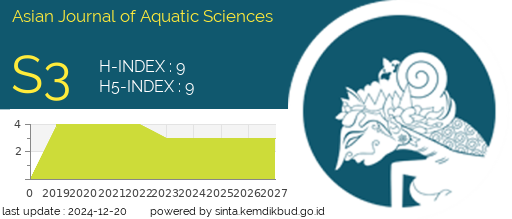ANALYSIS OF TYPES AND ABUNDANCE OF SOLID DOMESTIC WASTE IN THE COASTAL TOURIST AREA OF DUMAI CITY
DOI:
https://doi.org/10.31258/ajoas.7.2.312-317Keywords:
Dumai City, Coastal Tourism, Marine Ecosystem, Marine DebrisAbstract
The coastal areas of Dumai City in Riau Province are rapidly developing regions, especially in the tourism sector. This city offers several attractive beach destinations, such as Pasir Koneng Beach, Beringin Indah Beach, and Purnama Beach, attracting many local and international tourists. However, tourism growth in Dumai City also leads to an increase in solid domestic waste, which can threaten the coastal environment and the sustainability of marine ecosystems. This research aims to analyze the types and abundance of solid domestic waste in the coastal tourism areas of Dumai City. Through direct survey methods and descriptive analysis, samples of solid domestic waste were collected from three different beach locations: Purnama Beach, Koneng Beach, and Beringin Indah Beach. The results show that plastic waste is the most dominant type in all research locations, followed by wood and Styrofoam. Analysis of solid domestic waste's mass density and abundance indicates no significant difference between sampling stations or sampling times. This study provides a better understanding of the solid domestic waste issue in the coastal areas of Dumai City. It emphasizes the need for more effective management actions to maintain the sustainability of coastal tourism environments and prevent negative impacts on marine ecosystems and human well-being.
Downloads
References
1. Khalid, T.M. Pengaruh Pengelolaan Anggaran terhadap Pengembangan Pariwisata di Dinas Kebudayaan, Pariwisata, Pemuda dan Olahraga Kota Dumai Tahun 2011. Al-Hisbah Jurnal Ekonomi Syariah, 2022; 2(1): 58-67.
2. Hetherington, J., Leous, J., Anziano, J., Brockett, D., Cherson, A., Dean, E., Dillon, J., Johnson, T., Littman, M., Lukehart, N., Ombac, J., Reilly, K. The Marine Debris Research, Prevention, and Reduction Act: A Policy Analysis. Columbia University New York, New York. 2005.
3. Supriharyono, S. Pelestarian dan Pengelolaan Sumber Daya Alam di Wilayah Pesisir Tropis. Jakarta. 2002; 1-28.
4. Putawo, N.C., Wilmy, E.P., Hermanto, W.K., Josian, N., Schaduw, W., Indri, S., Manembu, E.L. Karakteristik Sampah Laut di Pantai Tumpaan Desa Tateli Dua Kecamatan Mandolang Kabupaten Minahasa. Jurnal Pesisir dan Laut Tropis, 2020; 8(1): 71-83
5. Johan, Y., Renata, P.P., Muqsit, A., Purnama, D., Meryani, L., Maryani, P., Hiriman, P., Rizky, F., Astuti, A.F., Yunisti, T. Analisis Sampah Laut (Marine Debris) di Pantai Kualo Kota Bengkulu. Jurnal Enggano, 2020; 5(2): 273-289
6. Bangun, S.A., Sangari, J.R.R., Tilaar, F.F., Pratasik, S.B., Salaki, M., Pelle, W. Komposisi Sampah Laut di Pantai Tasik Ria. Kecamatan Tombariri. Kabupaten Minahasa. Jurnal Ilmiah Platax, 2019; 7(1): 322-328.
7. NOAA [National Oceanic and Atmospheric Administration]. Marine Debris Impacts on Coastal and Benthic Habitats. NOAA (Marine Debris) Habitat Report. 2015.
8. Taruan, H.N., Wijaya, R.S., Saputra, Y.H. Pengolahan Limbah Kaca Menjadi Produk Seni Kaligrafi Gampong Jalin Kota Jantho. DESKOVI: Art and Design Journal, 2020; 2(2): 69-72.
9. Nursruwening, Y., Widyandini, W., Wahyuningsih, E.S. Pembuatan Handicraft menggunakan Bahan Olahan Sampah Domestik. Prosding SENATEK Universitas Muhammadiyah Purwokerto Purwokerto. 2015.







